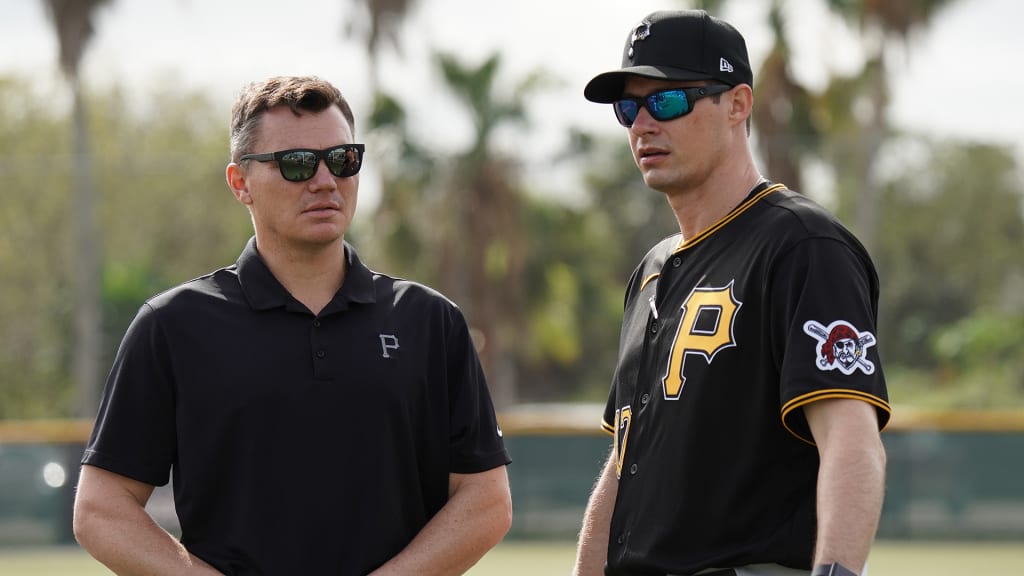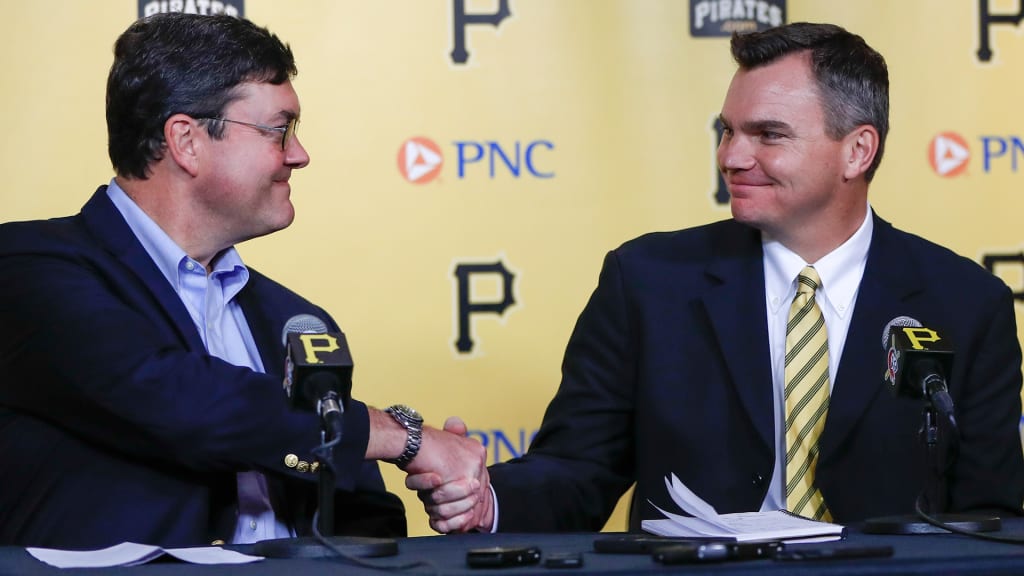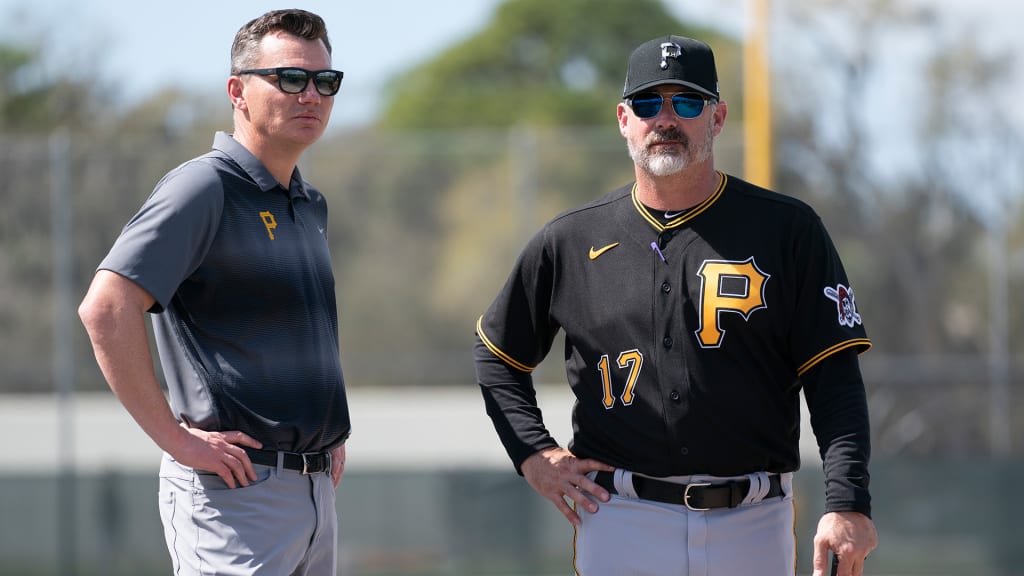
During Spring Training, Pirates general manager Ben Cherington sat down with MLB.com to discuss his first offseason on the job and what he’s learned since serving as general manager of the Red Sox from 2011-15. This is the third part of a series looking at how he’s applying those lessons in Pittsburgh.
PITTSBURGH -- Although his name appeared in the rumor mill when several high-ranking front-office jobs opened up in late 2015, Ben Cherington’s first job after leaving Boston wasn’t in baseball. It was in academia.
During spring 2016, he taught a graduate-level leadership course in the sports management program at Columbia University. He led discussions about sports and corporate leadership. He boiled down his experience as Boston’s GM into a case study for students. When he returned to baseball, he found himself in an environment where he could continue his own professional education.
In September 2016, the Blue Jays hired Cherington to be their vice president of baseball operations -- a vague title for what they expected to be a wide-ranging, behind-the-scenes job with an emphasis on player development. It gave him an opportunity to work with Toronto president Mark Shapiro and general manager Ross Atkins, both products of the Indians' front office where Cherington got his start. Atkins said they had been aggressively pursuing the former Red Sox GM.
“It's hard for me to think about Ben learning from us. At the same time, it's kind of his nature to always be learning,” Atkins said. “He’s exceptional. So we were learning together constantly.”
Cherington served as a mentor to director of player development Gil Kim, Atkins said. Cherington worked to integrate the Jays’ farm system with their high-performance department, helping Toronto create holistic training programs -- strength and conditioning, nutrition, mental health, etc. -- that were specifically designed for each player.
Over time, his emphasis on the Minor League system evolved into a focus on modern player development and pitching-development practices.
“Everybody that works there is really encouraged to continue learning. There’s a budget for it, resources committed to that, so I was just able to do a lot of that,” Cherington said. “You learn from the people you’re working with, for sure, but we also had a chance to get outside the Blue Jays and learn. I spent a lot of time just learning about player improvement all over again.”

Atkins credited Shapiro for introducing that concept to him back when Shapiro was in Cleveland’s front office and Atkins was a Minor League pitcher for the Indians in the late 1990s. Atkins was a 38th-round Draft pick, but he felt like Shapiro and his staff were as mindful of his development as that of a top prospect.
“I just wanted to make sure that every player always felt that,” Atkins said. “Everything that we do, we're trying to individualize it more as far as their learning, their growth, their development, so that they're not falling into things that are just mundane or routine and not specific enough.”
The possibility of player improvement truly struck Cherington in 2007. He spent years overseeing Boston’s Minor League system, creating development plans for many future Red Sox who stepped up during their World Series run. He met twice a year with those players in the Minors, mapping out their path forward based on their ability and upside and where they fit in the organization.
He thought he understood what they were capable of, only to see some exceed expectations at the game’s highest level.
“We're watching them on the field in the World Series or in the playoffs that year, and they're literally doing things that none of us were talking about three or four years before that,” Cherington said. “So I remember watching that and thinking, ‘Hmm. We ought to be really careful about unintentionally creating any sort of artificial ceiling, a limit on what a player is capable of,’ which I think unintentionally can happen when you're really focused on assessment.”
The day Cherington was hired by the Pirates, chairman Bob Nutting emphasized the GM’s passion for player development and his history of building from within. Cherington talked at length about player improvement and his four-pillar strategy to identify, acquire, develop and deploy talent. He later said the small-market Pirates have “simply no choice but to be good at” drafting and developing their own stars.
In recent years, Pittsburgh fell behind the player-development curve, despite having a highly ranked farm system for most of the past decade. From 2013-15, Pirates players produced 10 individual seasons of 4.0 Wins Above Replacement or better. They’ve put together a total of three 4-WAR seasons in the four years since.
It wasn’t necessarily an issue of identifying talent, but refining and utilizing it. The Pirates were briefly at the forefront of modernizing the game when they implemented aggressive defensive shifts and installed a traveling quantitative analyst in the clubhouse to serve as an intermediary between the front office and coaching staff.
But the Pirates became tied to the tenets of their 2013-15 success, like pitching down in the zone with two-seam fastballs and prioritizing on-base ability over power at the plate. While their stars regressed and their payroll shrunk, they also struggled to maximize their young players’ abilities as they experienced three losing seasons in the past four years.
After dismissing GM Neal Huntington, Nutting cited “painful, visible examples” of gifted players who significantly improved only after they were traded. Other forward-thinking teams, most notably the Astros (Gerrit Cole) and Rays (Tyler Glasnow and Austin Meadows), immediately identified and accentuated those players' strengths better than the Pirates had.
Cherington and manager Derek Shelton, who also worked in Toronto in 2017, have repeatedly discussed the importance of creating a “player-centered” culture in Pittsburgh, which involves the kind of player improvement exemplified by those former Pirates and the individualized training practiced by the Blue Jays.
“Some of the stuff, I think, is still constant from when I was a farm director 20 years ago. But there’s a lot that’s changed,” Cherington said. “Where the opportunities are for improvement. How that improvement happens. The resources we need to give the players the best chance to improve. The types of coaching and practice that are more optimal or have a better chance for success.”

So it’s no coincidence that there was a noticeable uptick in the Pirates’ use of technology -- high-speed Edgertronic cameras, Rapsodo tracking units and so on -- during their first Spring Training under Cherington and Shelton. The staff made information more accessible and digestible, and new pitching coach Oscar Marin joined hitting coach Rick Eckstein in striving to create an approach tailored for each player.
“A big thing is the players’ own awareness of where those opportunities are, and that’s a major change,” Cherington said. “Now, I think players are way more aware of what their own strengths and limitations are, where the opportunities are -- just way more aware of the information around them, which means that our job is much more to facilitate that players' improvement rather than direct it.”
Cherington helped the Blue Jays navigate that cultural shift in player development while Steve Sanders, now an assistant GM under Cherington, consistently restocked Toronto’s system as the Jays’ director of amateur scouting. Now, Toronto has a talented young roster and a well-regarded farm system to back it up.
The Pirates believe they will have a similar impact on their organization. One American League evaluator encapsulated the industry’s belief in Cherington’s ability to build a Minor League system by saying, simply, “Ben will figure it out.” Atkins expects he will, too.
“I'm sure you've heard ‘character’ mentioned a lot with him. He has a lot of it,” Atkins said. “He's going to excel. There's no doubt in my mind. He'll be there for a very long time, I would imagine, and have a lot of success.”


